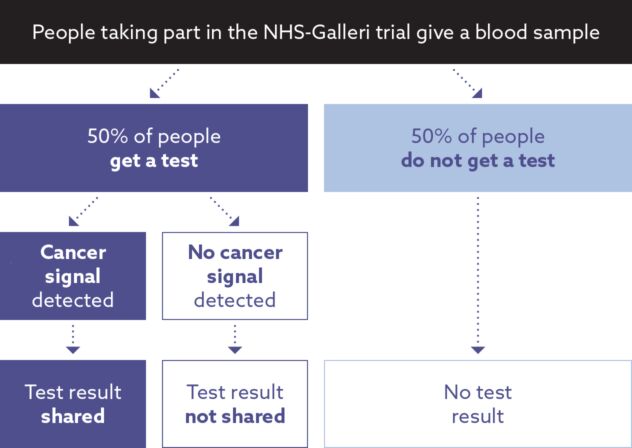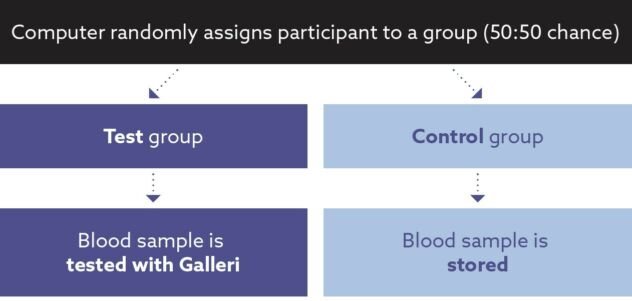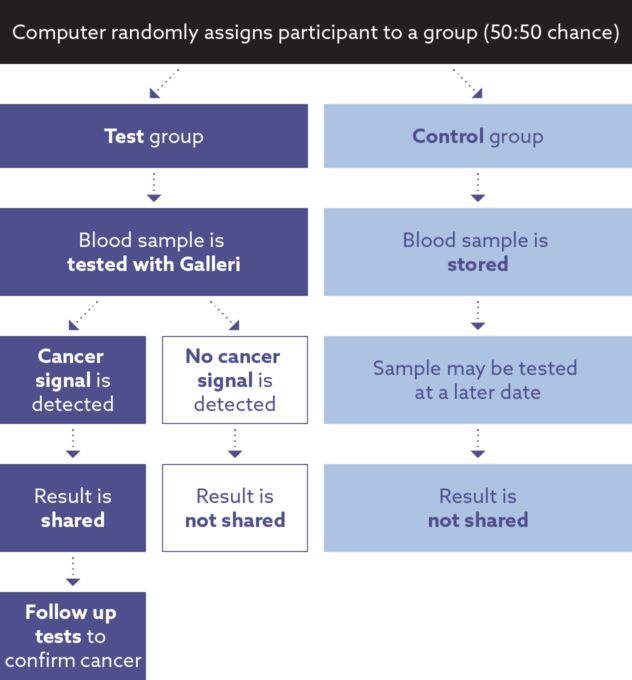Who received a Galleri® test
Key points
- At each appointment, participants in the NHS-Galleri trial gave a blood sample.
- Half of the people had their samples tested using the Galleri® test.
- Half of the people did not have their samples tested.
- Only people who had a Galleri test and had a cancer signal detected were sent their test result.
- This meant that most people in the trial did not get a test result.
 Half of the people in the NHS-Galleri trial had their blood samples tested using the Galleri test and the other half did not (50:50). Results were only shared with people who had a cancer signal detected test result.
Half of the people in the NHS-Galleri trial had their blood samples tested using the Galleri test and the other half did not (50:50). Results were only shared with people who had a cancer signal detected test result.
Test and control groups
Trials have to be designed in a particular way to understand how well a new test or treatment works.
The best way to learn this is to compare two groups of people: one group that did get the new test or treatment, and another that did not. These are called the “test” and “control” groups.
In the NHS-Galleri trial, half of the people in the trial are in the test group and half are in the control group.
Test group
People in the test group had their blood samples tested using the Galleri test. Anyone who had a cancer signal detected was contacted about their result. No other results will be shared.
Control group
People in the control group had their blood samples stored. Their samples may be tested in the future. They will not get any results, not even after the trial is finished. A control group is essential in research like this to provide a comparison with the test group.
During and after the trial, the test and control groups will be compared. One of the results that will be looked at is if cancers are found at an earlier stage in the test group than in the control group.
Additional information will be recorded about diagnostic tests and cancer treatments given.
Who gets a Galleri test
When you joined the trial, a computer randomly put you in the test or control group. This was like the computer flipping a coin- you had a 50:50 chance of being in either group.
You will not be told if you are in the test or the control group, not even after the trial has finished
If people know which group they are in, it might alter the way they behave about their health. This could make the research results less clear or reliable.
 People taking part in the trial were randomly put in the test or the control group, with a 50:50 chance of being in either group. Blood samples from the test group were tested using the Galleri test. Blood samples from the control group were stored.
People taking part in the trial were randomly put in the test or the control group, with a 50:50 chance of being in either group. Blood samples from the test group were tested using the Galleri test. Blood samples from the control group were stored.
Who gets a test result
Most people on the trial will not get a test result. Only people in the test group who had a cancer signal detected will be given their test result.
 Most people on the trial did not get a test result. Only people in the test group who have a cancer signal detected were given their test result.
Most people on the trial did not get a test result. Only people in the test group who have a cancer signal detected were given their test result.
Getting a cancer signal detected result
If you are in the test group, you will have been told if a cancer signal was found in your blood sample.
A cancer signal does not mean you definitely have cancer. It just means that you might have cancer, and you need to have some further tests to check.
A research nurse from the trial team contacted you about your result and arranged an appointment at an NHS hospital for further tests. Your GP was told about your result.
About half the people who have a cancer signal detected will be found to have cancer after further tests in the NHS, and the other half will not.
If the Galleri test finds a cancer signal, but no cancer is found after further tests, please continue to attend any cancer screening appointments you are invited to and visit your GP if you experience any symptoms that are new or unusual for you.
No other results will be shared
If you are in the test group and a cancer signal was not found, you will not be given your result. This is for two reasons:
We are still collecting information on how well the test works in the NHS, so it might give people false reassurance if they were told no cancer signal was detected.
In trials, people often do not know if they are in the test or control group. This is important for getting reliable research results. If you are told your test result, you will know you are part of the test group, which could make the research results less clear or reliable.
Attending your usual cancer screening appointments
It is very important that you keep attending your usual cancer screening appointments when you are invited to do so. You should also make an appointment to talk to your GP if you notice any symptoms that are new or unusual for you.
If you are in the control group, or if no cancer signal is found, you will have been sent a thank you letter to confirm that your blood sample was safely received by the lab. This normally takes around 30 days to arrive after you have had your blood sample taken, but may sometimes take longer.
You will not know from the letter if your blood sample has been tested or not. It is therefore important that you continue to attend any cancer screening appointments you are invited to and visit your GP if you experience any symptoms that are new or unusual for you.
The control group samples may be tested with the Galleri test in the future to help the trial team understand any differences between what happens to people in the test group and the control group. If you are in the control group, you will not get any test results from the trial, not even after the trial is finished. You will be asked if your samples can be stored and tested after the trial ends to help with other research to improve how well the test works.
Summary
When you joined the trial you were put at random into the test or the control group. There was a 50:50 chance (like flipping a coin) of being in either group.
If you are in the test group:
- Your blood samples were tested using the Galleri test
- You were told if a cancer signal was detected
- You will not be told any other results
If you are in the control group:
- Your blood samples were not tested using the Galleri test — they will be stored and may be tested in the future
- You will not be told any results
You will not be told if you are in the test or control group, not even after the trial has finished. This is to help make the research results clear and reliable.
